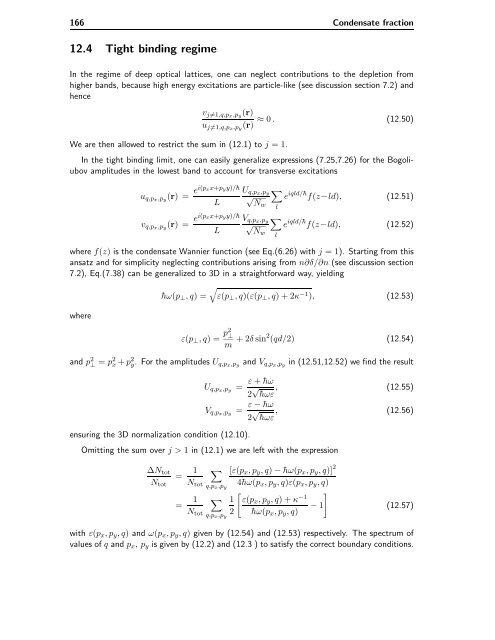Bose-Einstein Condensates in Rotating Traps and Optical ... - BEC
Bose-Einstein Condensates in Rotating Traps and Optical ... - BEC
Bose-Einstein Condensates in Rotating Traps and Optical ... - BEC
Create successful ePaper yourself
Turn your PDF publications into a flip-book with our unique Google optimized e-Paper software.
166 Condensate fraction<br />
12.4 Tight b<strong>in</strong>d<strong>in</strong>g regime<br />
In the regime of deep optical lattices, one can neglect contributions to the depletion from<br />
higher b<strong>and</strong>s, because high energy excitations are particle-like (see discussion section 7.2) <strong>and</strong><br />
hence<br />
vj=1,q,px,py (r)<br />
≈ 0 . (12.50)<br />
uj=1,q,px,py (r)<br />
We are then allowed to restrict the sum <strong>in</strong> (12.1) to j =1.<br />
In the tight b<strong>in</strong>d<strong>in</strong>g limit, one can easily generalize expressions (7.25,7.26) for the Bogoliubov<br />
amplitudes <strong>in</strong> the lowest b<strong>and</strong> to account for transverse excitations<br />
uq,px,py(r) = ei(pxx+pyy)/¯h<br />
L<br />
vq,px,py(r) = ei(pxx+pyy)/¯h<br />
L<br />
Uq,px,py<br />
√ Nw<br />
Vq,px,py<br />
√ Nw<br />
<br />
e iqld/¯h f(z−ld), (12.51)<br />
l<br />
<br />
l<br />
e iqld/¯h f(z−ld), (12.52)<br />
where f(z) is the condensate Wannier function (see Eq.(6.26) with j =1). Start<strong>in</strong>g from this<br />
ansatz <strong>and</strong> for simplicity neglect<strong>in</strong>g contributions aris<strong>in</strong>g from n∂δ/∂n (see discussion section<br />
7.2), Eq.(7.38) can be generalized to 3D <strong>in</strong> a straightforward way, yield<strong>in</strong>g<br />
where<br />
¯hω(p⊥,q)=<br />
<br />
ε(p⊥,q)(ε(p⊥,q)+2κ −1 ), (12.53)<br />
ε(p⊥,q)= p2 ⊥<br />
m +2δ s<strong>in</strong>2 (qd/2) (12.54)<br />
<strong>and</strong> p 2 ⊥ = p2 x + p 2 y. For the amplitudes Uq,px,py <strong>and</strong> Vq,px,py <strong>in</strong> (12.51,12.52) we f<strong>in</strong>d the result<br />
Uq,px,py =<br />
Vq,px,py =<br />
ε +¯hω<br />
2 √ ,<br />
¯hωε<br />
(12.55)<br />
ε − ¯hω<br />
2 √ ,<br />
¯hωε<br />
(12.56)<br />
ensur<strong>in</strong>g the 3D normalization condition (12.10).<br />
Omitt<strong>in</strong>g the sum over j>1 <strong>in</strong> (12.1) we are left with the expression<br />
∆Ntot<br />
Ntot<br />
= 1<br />
Ntot<br />
= 1<br />
Ntot<br />
<br />
q,px,py<br />
<br />
q,px,py<br />
[ε(px,py,q) − ¯hω(px,py,q)] 2<br />
4¯hω(px,py,q)ε(px,py,q)<br />
<br />
1 ε(px,py,q)+κ<br />
2<br />
−1<br />
<br />
− 1<br />
¯hω(px,py,q)<br />
(12.57)<br />
with ε(px,py,q) <strong>and</strong> ω(px,py,q) given by (12.54) <strong>and</strong> (12.53) respectively. The spectrum of<br />
values of q <strong>and</strong> px, py is given by (12.2) <strong>and</strong> (12.3 ) to satisfy the correct boundary conditions.




